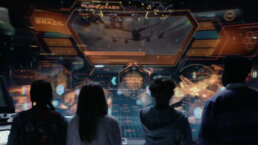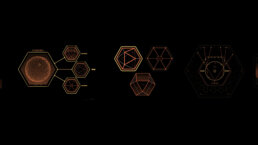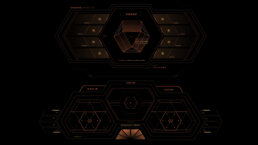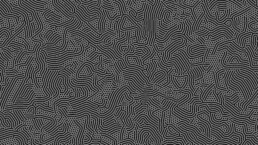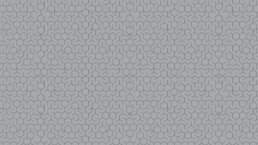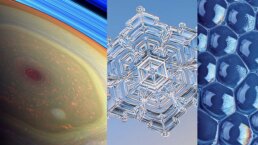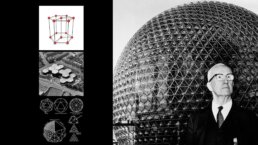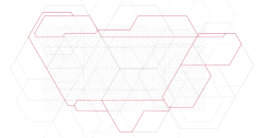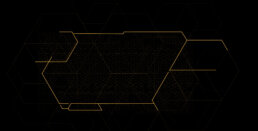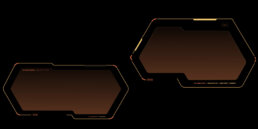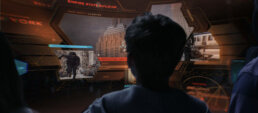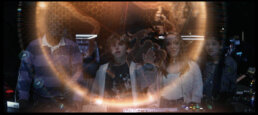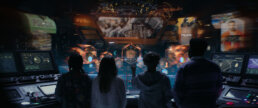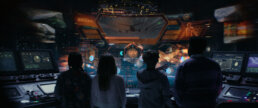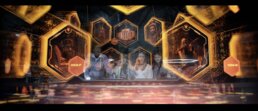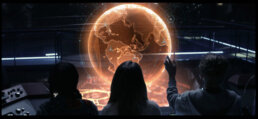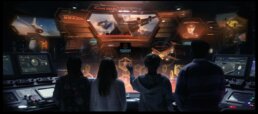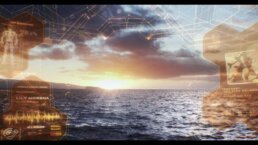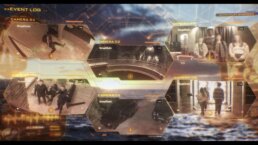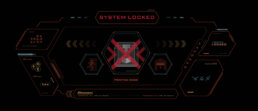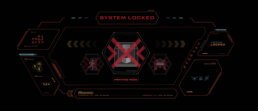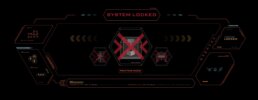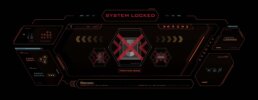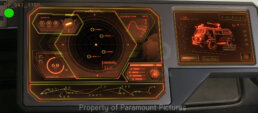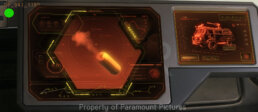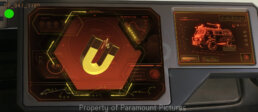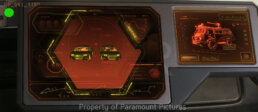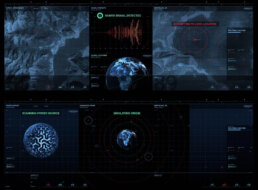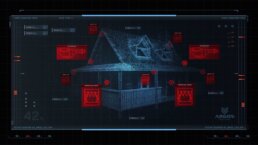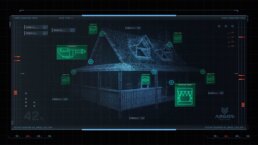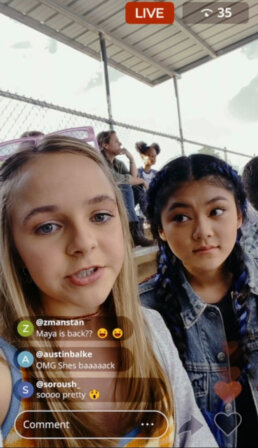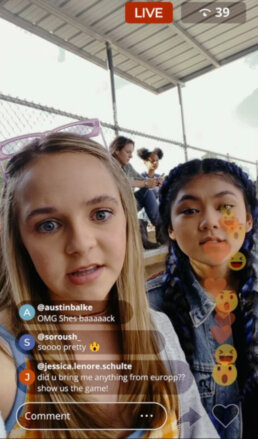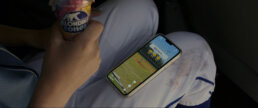01
INTRODUCTION
Our team at Perception collaborated with the team at Paramount on their new superhero film, Secret Headquarters. Secret Headquarters tells the story of Charlie Kincaid (Walker Scobell), his friends and their discovery of a superhero’s headquarters beneath his father’s home. Charlie and his friends soon learn that his father is actually the owner of this headquarters and is a famous superhero named the Guard. For this film, our team conceptualized various pieces of technology, as well as designed an opening title sequence to show the progression of the Guard’s rise to national heroism.
Secret Headquarters UI Montage
02
ALIEN TECHNOLOGY
The source of the Guard’s technology comes from an orb-shaped energy core. This core is from a distant, alien planet. When Jack Kincaid, also known as the Guard (Owen Wilson) discovers this orb, he uses his background as an IT expert to “hack” the core and create his own superhero technology that he can utilize and is familiar to him. Since the technology Jack creates is a mixture of Earthly-inspired technology and other-worldly alien technology, we combined these two looks and aesthetics in our designs.
INITIAL UI ELEMENT DEVELOPMENT
03
PATTERNS IN THE WORLD
The most notable features of the source are its orange coloring and distinct patterns. Since all of the Guard’s technology is created from this orb, we conceptualized each piece of the Guard’s technology to have this same coloring and shaping.
PATTERN EXPLORATION
However, we didn’t want each piece of technology to be an exact reflection of the orb’s patterns since the Guard was putting his own spin on its creations. Our team researched patterns that appear in the natural world, such as repetitive bubbles, rings on planets, snowflakes and geometric stacking designs. We also studied various types of architecture for a more human-based look. We aimed to develop a pattern that was repeatable, stackable and looked like the Guard’s energy source but is influenced by the real world.
STUDY OF PATTERNS AND REPETITION IN NATURE AND ARCHITECTURE
Using our research, we built a framework for everything that could live in a hexagonal design sphere and experimented with how these patterns could be applied to each piece of technology in a unique manner. For example, for our screen shapes, we crafted them to be moveable and flexible so they could be arranged in the shape of these natural patterns.
APPLYING FLUID PATTERNS TO POTENTIAL SCREEN AND UI SHAPES
04
BUILDING THE TECHNOLOGY
To begin the design process, we received previews from the film’s production team, along with a rough cut edit of how their team envisioned the ways the technology could be applied into the scene. This provided us with a basis for our designs and helped guide us towards the application of the technology. We then received plates and footage and began tracking everything. Once everything had been tracked, we had a 3D space to work in.
LOOK DEVELOPMENT OF HOLOGRAMS
From there, we plugged our footage into our 3D programs and built the actual elements in the same space as if it was being shot by the film’s camera to start. We built everything in 3D and created some motion and depth tests to match the camera’s depth of field. We then got our renders out of Cinema4D and added color effects and comped in Adobe After Effects. The last stage included the color pipe for the film and pushing everything into Nuke to composite and render. Lastly, our designs were color graded and sent to DI for the final edit.
REFINING THE HOLOGRAMS
05
THE GUARD'S TECHNOLOGY
HOLOGRAMS
One of the first pieces of the Guard’s technology that the children in the film see are his various holograms. These holograms include a welcome animation, a globe and various mission report files. We began by conducting different look explorations for how we could lay out the various hologram screens.
INITIAL EXPLORATION OF MISSION HOLOGRAMS
As we honed in on our design, we conducted motion tests to develop the fluidity of the holograms. We used these motion tests to align with the actors’ gestures, letting each screen show how user compatible it is.
Mission Holograms Motion Test
Welcome Hologram Motion Test
Based on our motion tests, we solidified the holograms to truly be entirely interactive with the ability to be moved, touched and spun to reveal more information and details. Each hologram is based on an orange color pattern, like the source itself, and includes hints and reflections of the hexagonal pattern.
Mission Holograms Final Design
Towards the end of the film, the headquarters is close to being taken over and overrun. As the villains from Argon infiltrate the headquarters, we see various holograms that they examine to get a better idea of who this headquarters belongs to and where the owner currently is.
Look Development of Takeover Holograms
Takeover Holograms Final Look
THE GUARD'S HUD
The Guard’s HUD gives the audience an inside view of what the Guard sees when he’s in his superhero suit. Our initial explorations allowed us to discover the most logical viewing layout of the UI and how to match the style of the rest of the Guard’s tech.
CONCEPT LAYOUT FOR THE GUARD'S HUD
We conducted several motion tests to map out the best course of movement to display and shift each piece of information throughout the HUD.
Since this is a more light-hearted film, we wanted to play around with various details and Easter eggs that the Guard could be viewing. Still based in hexagonal forms, our team included background statistics and metrics seen in the UI, such as oxygen and methane levels. We also experimented with some more playful details, including current music tracks that the Guard could be listening to, along with a warning of high levels of feet smell!
Final Design of the Guard's HUD
3D PRINTING
Since the Guard’s technology has to be transferred from the energy source, we designed a 3D printing interface that shows how each piece of technology can be created.
3D Printing Interface Motion Tests
This screen is a touch pad that features alien typography and sample icons of what can be printed. This feature is used in the beginning of the film to demonstrate how the Guard made his suit.
3D Printing Interface Flat Final Design
At the end of the film, we see the 3D printing screen become glitchy and dysfunctional. Our team also created this glitch effect for the interface.
3D Print Interface Glitch Motion Test 1
3D Print Interface Glitch Motion Test 2
Final 3D Print Interface and Glitch Effect
SYSTEM LOCK AND ACCESS CODES
When Charlie and his friend get locked in the 3D printing room, two of his friends aid in helping them escape from the outside. To do this, the children must unlock the room using a correct access code.
CONCEPTS FOR SYSTEM LOCK HOLOGRAMS
Our team conceptualized the system lock holograms, along with the access code hologram to demonstrate the progression, failure, and eventual success of the children testing each possible code. We conducted motion tests to lock down the speed and timing of these holograms.
System Lock Motion Test
Since this is such a tense scene that involves quick thinking from the children, our holograms were steady and unwavering, but moving incredibly quickly in order to reflect the sense of urgency and desperation from the situation.
Final System Lock and Access Codes Design
VAN INTERFACES
The Guard’s technology is not only bound to his headquarters. The Guard also has a van that he utilizes to travel. In the film, Charlie and his friends try driving this van and soon find that they are being followed. We designed the various screens and interfaces in this van that help the children escape. We began by crafting some initial look explorations for the interface.
Concept Van Touch Screen Interfaces
We then moved onto motion tests that would reflect pre-filmed footage of the children interacting with the blank screen. This helped perfect timing and coordinated buttons and functions to where the actors had already interacted with the empty interface while filming.
Van Touch Screen Interface Motion Tests
Since these screens are meant to be used while the Guard is driving, their functions were designed to be easy to read with a glance while still staying true to the look of the rest of the Guard’s technology.
Van Touch Screen Interface Final Look
06
ARGON TECHNOLOGY
INSPIRATION
Along with designing alien technology for the Guard, we also conceptualized technology for Ansel Argon (Michael Peña) and the Argon team. Argon’s technology is completely based in real-world technology with no outer-space impact.
EARLY EXPLORATION OF THE ARGON SCREENS
We developed his technology with CIA influences and a complex, utilitarian aesthetic. Since Argon is trying to secretly take down the Guard, we wanted this technology to feel as if it was a bit underground, reflective of secret-service interfaces.
Argon Technology Screens Motion Tests
TRACKING SCREENS
Argon’s tracking screens help the team discover the location of the Guard’s van, which leads them to the headquarters. These screens consists of features such as camera feeds, data and metrics, and constant tracking information.
Instead of the bright, glowing orange coloring of the Guard’s technology, Argon’s screens are based in a blue and gray color palette. Since Argon’s tech is more utilitarian, its patterns align more with a standard military grid rather than a fluid hexagonal shape.
Final Argon Tracking Screens
TABLET AND PHONE SCREENS
We also conceptualized Argon’s phone and tablet screens, which help him locate the base under Jack’s house and activate a bomb within it.
Argon Tablet Look Development
These screens share the same blue and gray color palette and military grid system. Everything about Argon’s technology is direct, practical and tactical, even in its mobile form.
Final Argon Tablet
Final Argon Phone
07
ADDITIONAL FEATURES
ALIEN TYPOGRAPHY
Much of the technology that the Guard uses has flares of alien typography mixed in, since this tech is formed from the alien energy source. Our team developed this unique typography to be custom made for this film. We experimented with various typefaces, and ultimately landed on a hexagonal shaped text that reflects the patterns of the source. This typography can also be seen throughout the opening title sequence we designed.
LOOK DEVELOPMENT OF ALIEN TYPOGRAPHY
THE SOURCE'S FUTURE VISION
When both Jack and Charlie first touch the source, they are met with a quick, seven second vision that shows them the future. Our team organized and edited this speedy narrative. Our greatest task was finding the clearest and most concise way to communicate how important each portion of this vision was. Our final direction landed on mixing graphic glimpses of clips and images with mixtures of both English and alien typography. This helped establish that the alien source was showing what could potentially happen to Earth if not intervened by a hero.
The Source's Future Vision Final Sequence
NEWS SCREENS
In the beginning of the film, there is a news report and interview with Argon. Our team designed each of the lower thirds seen in the news segment and the interview.
Final News Lower Thirds
We experimented with different layouts and styles before landing on our final direction.
Concept News Lower Thirds
We also crafted the technology inspired globe seen behind Argon.
PHONE SCREENS
Technology plays a huge role in the film, even outside of the complex gear of the Guard and Argon. The children are seen in this film using phones, sending messages and watching TikToks. Our team designed all of these phone screens and even a fake TikTok for the children to interact with. These screens also indicate the gap in advancement between our Earthly technology and the technology that the source is able to create for the Guard
08
CONCLUSION
It was an honor to collaborate on so many different features of Secret Headquarters with the team at Paramount. We loved experimenting with such unique and complex technology designs for all of the Guard’s UI and holograms, along with developing various storytelling methods for the narrative opening title sequence. Secret Headquarters is now streaming on Paramount+.
See more of our contributions to Secret Headquarters in our Secret Headquarters Title Design case study – coming soon!
